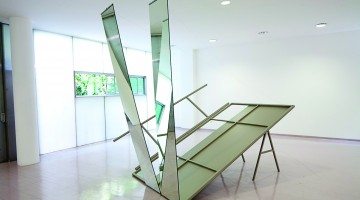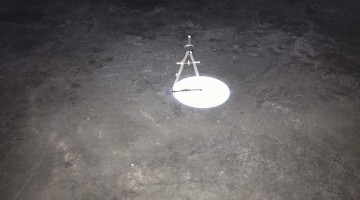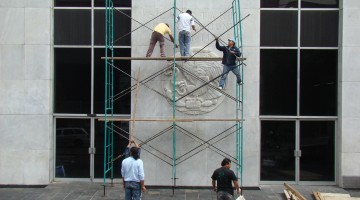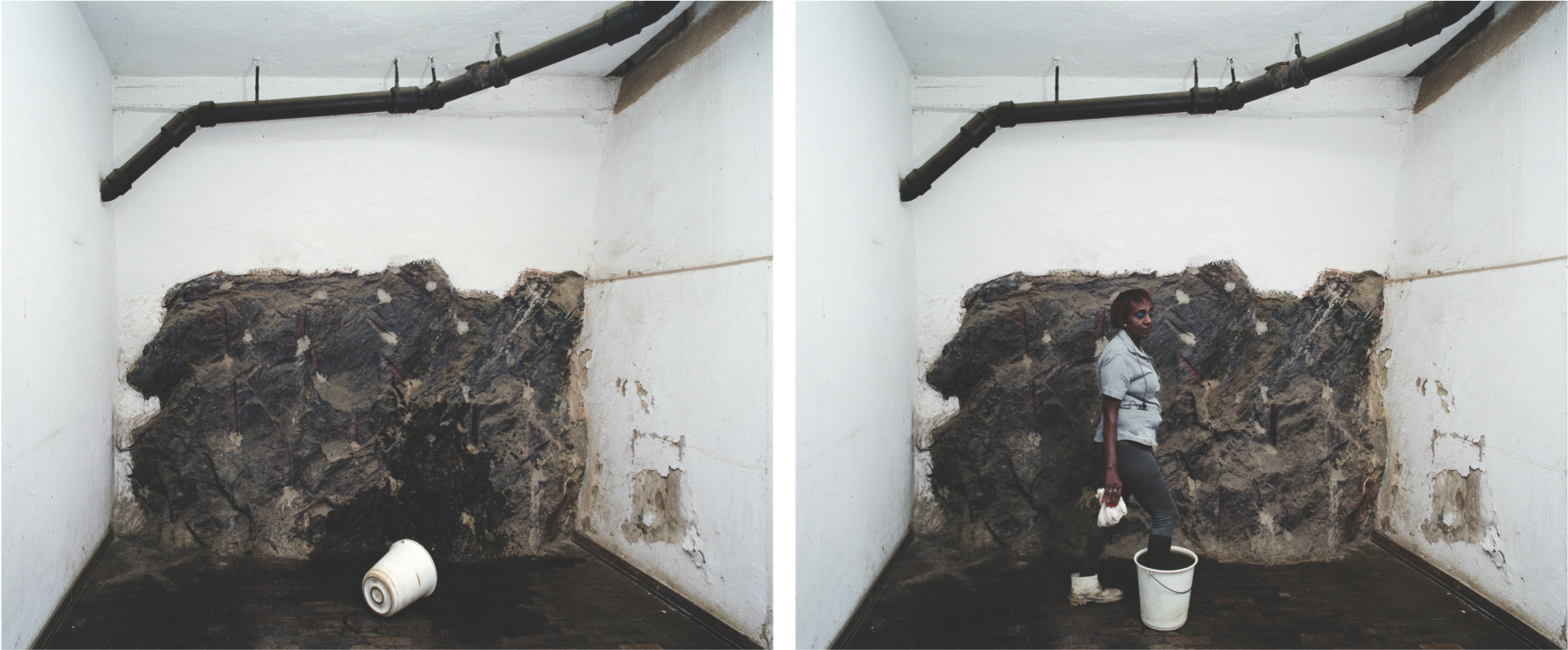Read the English version of this article.
Curadores De Zona Maco Sur 2015 En Conversación Con DFAQ
Desde su punto de vista, ¿cuáles son los ejes temáticos más contemporáneos y relevantes en la labor de trabajar con estos artistas diseminados a lo largo de Centro y Su- damérica?
Primero que nada, no sólo estamos trabajando con gente de Latino-américa. Estamos conscientes de que la feria ocurre en un contexto geográfico (y sociopolítico) específico, pero tratamos de expandir la sección Sur más allá de los límites de Latinoamérica. Supongo que la razón principal de esta estrategia es que ninguno de nosotros dos es latinoamericano. Sin embargo, nos sentimos fuertemente vinculados con el concepto de Sur, tanto como metáfora como imperativo ético, ya que ambos somos de Portugal, un país del sur de Europa que está luchando tremendamente con una severa crisis económica y con la nueva división norte-sur que actualmente está partiendo a Europa en dos.
Para esta edición específica de Sur, y dados nuestros contextos y respectivos campos de investigación, nos interesa más desarrollar un enfoque curatorial especulativo que trabajar con temas específicos. Más específicamente, nos interesa la manera en que uno produce el futuro mediante la imaginación, pero también a través del conocimiento y la acción. Y en cierto modo, eso es lo que tratamos de abordar con nuestro caso de estudio #1.
Actualmente estamos en proceso de desarrollar una especie de aparato curatorial que nos permita, tanto a nosotros como a los artistas, los coleccionistas y a la audiencia, pensar en cuál futuro tenemos la capacidad de imaginar y producir en este momento específico en el tiempo. El proyecto incluye presentaciones individuales y también un panel performativo en el que estaremos involucrados directamente con la producción de lo que está por venir.
¿Cómo se imaginan que el contexto de la Ciudad de México, y en especial el de Zona Maco, cambie la manera en que la gente se aproximará a los artistas participantes en su encarnación de Zona Maco Sur?
La Ciudad de México que imaginamos (siendo la imaginación una palabra clave en nuestro proyecto) es una ciudad extremadamente cosmopolita, con una larga tradición de compromiso con las artes. No es para nada distinta a Nueva York, São Paulo o Los Ángeles. En ese sentido, no esperamos que la percepción que la gente tenga de nuestro proyecto, y de los artistas que hemos invitado, sea distinta de la que podría tener en esas ciudades.
Supuestamente, los artistas involucrados en Zona Maco Sur son parte de “proyectos de exposición individual.” ¿Qué tan importante es la idea de la autonomía artística frente al reto de curar a un grupo de individuos que se reúnen bajo la etiqueta “Sur”, presumiblemente basada en sus países de origen?
Como lo mencionamos antes, y para esta edición, Sur está menos conectado con una situación geográfica o un tema específico, que a una condición especulativa que queremos habitar.
Lo que nosotros entendemos como “el sur”, viniendo de Portugal, probablemente es muy distinto de lo que “el sur” significa para ti o lo que significa en el contexto de Zona Maco Sur. ¿Puede el sur ser un espacio de imaginación especulativa? ¿Podemos recuperarlo como una herramienta para producir el mundo en que deseamos vivir? No lo sabemos, y es por eso que lo llamamos un caso de estudio.
Los artistas que invitamos no están representando ninguna geografía o nación. No representan nada más que su propia visión subjetiva del mundo, y ésta es una condición sumamente importante, de la cual partimos siempre y a la que nuestros proyectos están anclados. Esta visión específica del mundo, con la que ellos contribuyen al proyecto, es compleja y especulativa, y es también la razón por la que los hemos invitado a formar parte de Sur.
Si es que los hay, ¿cuáles son los principios o algoritmos que se han fijado como criterio para incluir o no incluir galerías y/o proyectos?
Otra vez, la imaginación es una palabra clave, pero otra palabra clave es la especulación. Mientras que la imaginación puede verse como la clave curatorial de este proyecto, la especulación puede ser entendida como una clave artística. Todos los artistas que seleccionamos están comprometidos, en cierta medida, con la especulación como un modus operandi importante. Incluso, aunque el resultado final de nuestra propuesta pueda parecer inconexo al principio, estamos buscando un enfoque digresivo, que se ramifique en un millón de maneras distintas, de las cuales, cada una puede ser una nueva posibilidad, en lugar de simplemente enfocarnos en una única narrativa, un tema o una voz que pudieran reducir nuestras posibilidades de imaginar el futuro.

Petrit Halilaj, I Don’t Have a Room, I Don’t Have a Mind, Nevermind!, 2014. Mixed media. Installation view at Chert, Berlin. Courtesy of Zona Maco.
¿Zona Maco ha atraído la atención hacia las cuestio- nes que los artistas de Sudamérica quieren expresar, mediante el conducto de la explosiva escena artística de la Ciudad de México?
Definitivamente diríamos que sí.
Finalmente, ¿cómo creen ustedes que Zona Maco ha o no ha “definido” la concepción del arte latinoamericano?
Tendemos a sospechar un poco de cualquier definición nacional o geográfica de las prácticas artísticas contemporáneas. No obstante, si uno observa el papel que Zona Maco ha desempeñado a lo largo de los años, es obvio que ha sido de crucial importancia en definir un espacio de alta visibilidad para las prácticas artísticas que vienen de, o se refieren a, Latinoamérica. Pero no ha sido un esfuerzo solitario; creemos que ha sido la actividad coordinada de artistas, curadores, críticos, galerías, coleccionistas y museos a lo largo de los años lo que ha resultado en la posición que ocupa hoy en día.
Zona Maco se llevará a cabo del 4-8 de febrero, 2015, en la Ciudad de México
Curators Of Zona Maco Sur 2015 In Conversation With DFAQ
What do you see as being the most contemporary and relevant themes as you work with these artists who are spread across Central and South America?
First of all, we are not only working with artists from Latin America. We do acknowledge the fact that the fair is taking place in a specific geographical (and socio-political) context, but we are trying to expand the “sur” section beyond the limits of Latin America. I guess the main reason for that is that neither of us is from Latin America. We do relate strongly to the concept of south, both as a metaphor and as an ethical imperative, since we are both from Portugal, a southern European country struggling tremendously with a severe economic crisis and with the new north-south divide that is currently splitting Europe in half.
For this specific edition of Sur, and given both our backgrounds and our fields of research, we are more interested in developing a speculative curatorial approach than working with specific themes. More specifically, we are interested in the way in which one produces the future through imagination, but also through knowledge and action. And in a way, that is what we are trying to address with our case study #1.
We are currently in the process of deploying a curatorial device of sorts that will enable us, but also the artists, the collectors, and the audience to think about what future we are able to imagine and produce at this specific moment in time. The project includes solo presentations and also a performative panel in which we will engage directly with producing what is yet to come.
How do you imagine the context of Mexico City, and es- pecially of Zona Maco, changing how people will come to view the artists taking part in your incarnation of Zona Maco Sur?
The Mexico City we imagine (imagination being a keyword of our project) is an extremely cosmopolitan city, with a long tradition of engagement with the arts. It isn’t any different from New York, São Paulo, or L.A. In that sense we don’t expect the perception people will have of our project and the artists we’ve invited to be that different from that which people from those cities would have.
The artists involved with Zona Maco Sur are supposedly part of “solo show projects.” How important is the idea of artistic autonomy in the face of curating a group of individuals that have been designated “sur,” presumably based on the countries they are from?
As we mentioned before, and for this edition, Sur is less connected to a specific geographical situation or a specific theme than to a speculative condition we wish to inhabit.
What we understand as “the south,” coming from Portugal, is probably very different from what “the south” means to you or what it means in the context of Zona Maco Sur. Can the south be a place of speculative imagination? Can we recover it as a tool for producing the world in which we want to live? We don’t know and that’s why we call this a case study.
The artists we invited aren’t representing any geography or nation. They represent nothing other than their own subjective view of the world, and this is an extremely important condition from which we always depart and in which our projects are grounded. This specific view of the world, which they are contributing to the project, is a complex and speculative one and is the reason we invited them to be part of Sur.
What are, if any, the principles or algorithms that you have set as a marker for which galleries and/or projects get in- cluded?
Again, imagination is a keyword, but another keyword is speculation. While imagination can be seen as a curatorial keyword for this proj- ect, speculation can be understood as an artistic keyword. All of the artists we selected are committed to a certain degree to speculation as an important modus operandi. Even though the end result of our proposal may look disjointed at first, we are looking for a digressive approach, branching out in a million different ways, each of which can be a new possibility, rather than simply focusing on one single narrative, or theme, or voice that would narrow down our possibilities of imagining the future.
Has Zona Maco brought attention to issues that South American artists want to express via the conduit of the exploding Mexico City art scene?
We would definitely say yes.
Finally, how do you think Zona Maco has or has not “de- fined” what is considered Latin American art?
We tend to be somewhat suspicious of national or geographical definitions of contemporary artistic practices. Nevertheless, if one looks at the role Zona Maco has had over the years, it is obvious that it has been of paramount importance in defining a place of high visibility for artistic practices that come from or refer to Latin America. But it hasn’t been a solitary endeavor; we think it has been the articulated activity of artists, curators, critics, galleries, collectors, and museums over the years that has resulted in the position it occupies today.
Zona Maco will take place February 4th-8th, 2015, in Mexico City.








